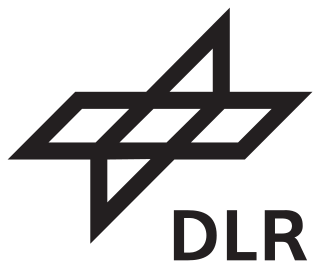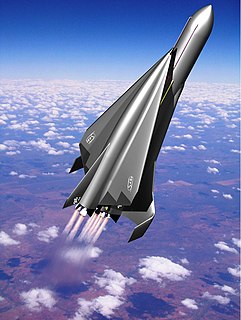Related Research Articles

The Docklands Light Railway (DLR) is an automated light metro system serving the redeveloped Docklands area of London, England and provides a direct connection between London's two major financial districts Canary Wharf and the City of London First opened on 31 August 1987, the DLR has been extended multiple times, giving a total route length of 38 km (24 mi). Lines now reach north to Stratford, south to Lewisham, west to Tower Gateway and Bank in the City of London financial district, and east to Beckton, London City Airport and Woolwich Arsenal. Further extensions are under consideration.

The German Aerospace Center, abbreviated DLR, is the national center for aerospace, energy and transportation research of Germany. Its headquarters are located in Cologne and it has multiple other locations throughout Germany. The DLR is engaged in a wide range of research and development projects in national and international partnerships. In addition to conducting its own research projects, DLR also acts as the German space agency. As such, it is responsible for planning and implementing the German space programme on behalf of the German federal government. As a project management agency, DLR also coordinates and answers the technical and organisational implementation of projects funded by a number of German federal ministries.

A mission control center is a facility that manages space flights, usually from the point of launch until landing or the end of the mission. It is part of the ground segment of spacecraft operations. A staff of flight controllers and other support personnel monitor all aspects of the mission using telemetry, and send commands to the vehicle using ground stations. Personnel supporting the mission from an MCC can include representatives of the attitude control system, power, propulsion, thermal, attitude dynamics, orbital operations and other subsystem disciplines. The training for these missions usually falls under the responsibility of the flight controllers, typically including extensive rehearsals in the MCC.
This is an index of articles relating to soil.
A bevameter is a device used in terramechanics to measure the mechanical properties of soil. Bevameter technique was developed to measure terrain mechanical properties for the study of vehicle mobility. The bevameter test consists of penetration test to measure normal loads and shear test to determine shear loads exerted by a vehicle. Bevameter area size need to be the size of the wheel or track. DEM analysis can take data from one size and simulate bevameter performance for a different size.

Docklands Light Railway rolling stock is the passenger trains and service vehicles used on the Docklands Light Railway (DLR), which serves the London Docklands area in the east of London.

Hyde Road was a railway station in Gorton, Manchester, England, on the Fallowfield Loop Line. It opened in 1892 and closed in 1958 when local passenger services on the line stopped. The station was sometimes advertised as Hyde Road for Belle Vue, that is, convenient for Belle Vue Zoo, about one mile away. The track closed completely in 1988 and the track was taken up. The station has long since been demolished, and the site has now been partly redeveloped. The line of the track is used as a cycleway.
The Forschungsflugkörper was a sounding rocket manufactured by ERNO from 1972 to 1974 for the DLR. It was a single stage rocket that consisted of 1xFFK. Germany was the country that developed and tested this spacecraft. It had 3 launches, two of which were failures. It was a fairly small craft with a weight of 300 kg, a length of 4.00 metres, a core diameter of 0.25 metres, and apogee of 120 km.
Walter Söhne was a pioneer in research on soil mechanics (terramechanics) and on improving the design of agricultural vehicles, and was a very successful teacher as a professor from 1965 to 1982 at the Technical University of Munich. He wrote many articles in German on related topics, and his Über die Historie der Bodenbearbeitungs- und Erntetechnik (1992) surveys the history of techniques of agricultural cultivation and harvesting. In the 1970s he served as president of the International Society for Terrain Vehicle Systems.

The Columbus Control Centre also known by its radio callsign, Mission Control Munich, is the mission control centre which is used to control the Columbus research laboratory, which is part of the International Space Station (ISS). The control centre is located at the German Aerospace Center (DLR) facility in Oberpfaffenhofen near Munich, Germany. The centre is operated by the DLR, under contract from the European Space Agency (ESA).

SpaceLiner is a concept for a suborbital, hypersonic, winged passenger supersonic transport, conceived at the German Aerospace Center in 2005. In its second role the SpaceLiner is intended as a reusable launch vehicle (RLV) capable of delivering heavy payloads into orbit.

The VLM is a proposed three-stage satellite launcher being developed by the Brazilian General Command for Aerospace Technology in collaboration with Germany. The project originated in 2008 as a simplified version of the VLS-1 rocket, using only the core stages. The first launch is currently planned for no earlier than 2023.

SHEFEX, is an experiment conducted by the German Aerospace Center (DLR), for the development of some new, cheaper and safer design principles for space capsules, hypersonic vehicles and space planes with re-entry capability in the atmosphere and their integration into a complete system.
IRS-P3 was the sixth satellite in Indian Remote Sensing satellite series, an Earth observation mission launched under the National Natural Resources Management System programme (NNRMS) undertaken by Indian Space Research Organisation (ISRO). The objectives of the mission were processing and interpretation of data generated by its two instruments, the Wide-Field Sensor (WiFS) and Modular Opto-electric Sensor (MOS), developed by the German Aerospace Center (DLR).
Alan Richard Reece (1927-2012) was the owner director of Pearson Engineering Ltd, Newcastle upon Tyne. In 2012 his company won the Queen’s Award for Enterprise in Innovation. Pearson Engineering developed a range of counter-mine rollers that attach to the front of wheeled and tracked military vehicles to trigger an explosion as they drive over improvised explosive devices. The rollers get blown up and the main vehicle and its occupants stay safe.

The Essen Stadtbahn is a 19.6-kilometer (12.2 mi) light rail (Stadtbahn) network in Essen and the two neighbouring towns of Mülheim an der Ruhr and Gelsenkirchen in the German state of North Rhine Westphalia. It forms part of the Rhine-Ruhr Stadtbahn.

Liquid Fly-back Booster (LFBB) was a German Aerospace Center's (DLR's) project concept to develop a liquid rocket booster capable of reusing for Ariane 5 in order to significantly reduce the high cost of space transportation and increase environmental friendliness. LFBB would replace the existing solid rocket boosters, providing main thrust during the liftoff. Once separated, two winged boosters would perform an atmospheric entry, fly back autonomously to the French Guiana, and land horizontally on the airport like an aeroplane.

Eu:CROPIS was a life science satellite developed by the German Aerospace Center (DLR) and intended to investigate the possibility of growing plants in different levels of gravity, such as that of the Moon and Mars, as a sustainable food source using human urine for moisture and as the source of fixed nitrogen.

A tracked articulated vehicle or articulated tracked vehicle, is a variation of a continuous track vehicle that consists of two cars, each with their own track, most commonly with an actuated linkage in between. This configuration allows an articulated tracked vehicle to turn by articulating the swivel joint in between the two vehicles, as opposed to using differential steering to move one track faster than the other.
Corina Sandu is a Romanian-American mechanical engineer, the Robert E. Hord Jr. Professor of Mechanical Engineering at Virginia Tech. Her research topics include multibody systems, vehicle dynamics, and terramechanics, the interactions between soil properties and vehicle dynamics.
References
- 1 2 "DLR – Institute of Robotics and Mechatronics – Terramechanics". www.dlr.de. Retrieved 6 May 2020.